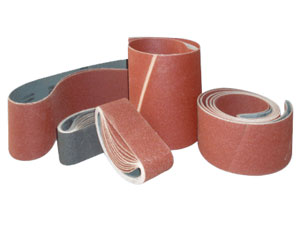
Resources
- Home
- About Abrasive Sanding Belts
- Abrasive Sanding Belt
- Abrasive Sanding Belts FAQ
- Abrasive Sanding Belts Reviews
- Best Abrasive Sanding Belts
- Cost Of Abrasive Sanding Belts
- Guide To Using Abrasive Sanding Belts
- Recommended Abrasive Sanding Belts
- Types Of Abrasive Sanding Belts
- Where To Buy Abrasive Sanding Belts
Abrasive Sanding Belts FAQ
1. What are the standard materials that make up coated abrasive sanding belts?
The coated abrasive sanding belts are made of:
- Grain – natural or synthetic type of abrasive material
- Backing – component of the abrasives where the abrasive material is attached to
- Bond – adhesive material that attaches the abrasive with the backing material
2. What are the different types of abrasive grain materials of coated abrasive sanding belts?
- Aluminum oxide – This man-made abrasive grain material is reddish or brownish in color and is known for its durability and high resistance to wear. It is normally used for cutting sharp edges. It is the preferred abrasive sanding belt for leather, hardwood, ferrous metals and aluminum.
- Silicon Carbide – This hard synthetic abrasive grain material comes in black color. It has high friability and allows for fast removal of stock. It is ideally used for soft woods, plastics, rubber, glass, non-ferrous metals, bronze and aluminum.
- Crocus – This reddish brown abrasive grain material is made out of iron oxide. This natural fine grain is ideal for cleaning as well as fine polishing of gold and other soft materials.
- Zirconia Alumina – This bluish-gray heavy-duty synthetic abrasive grain material comes with outsized fracture planes and is sharper than the aluminum oxide abrasive grain material. It is only available in grits with coarser texture and is normally used for rough planning and grinding of ferrous and non-ferrous surfaces and edges.
- Garnet – This reddish brown abrasive grain material has moderate sharpness and is designed for pine, fir and other soft wood surfaces and edges.
3. What are the different adhesives used in abrasive sanding belts?
- Glue – This abrasive bonding material is used in a system where the degree of adhesion is not the prime consideration, just like in paper and other lightweight materials.
- Urea Resin – This abrasive bond is known for its higher resistance to frictional heat compared to the other types of adhesives used in abrasive sanding belts.
- Phenolic Resin – This adhesive system for sanding belts makes use of phenolic resin material. It is heat resistant and moisture resistant and is the leading abrasive bond when it comes to durability.
- Glue-Resin Composite Bond – This adhesive system makes use of animal glue for the make coat and phenolic or urea resin for the size coat. This is designed for sanding jobs where both heat resistance and durability are essential.
4. What are the raw materials used in making nonwoven abrasive sanding belts?
- Grain - natural or synthetic type of abrasive material
- Resin System – adhesive system that fuses the fiber material with the abrasive grain.
- Fiber Weave – special fibers made of nylon or polyester.
5. What are the different types of abrasive grain materials of nonwoven abrasive sanding belts?
- Aluminum oxide – This man-made abrasive grain material is reddish or brownish in color and is known for its durability and high resistance to wear. It is normally used for cutting sharp edges. It is the preferred abrasive sanding belt for leather, hardwood, ferrous metals and aluminum.
- Silicon Carbide – This hard synthetic abrasive grain material comes in black color. It has high friability and allows for fast removal of stock. It is ideally used for soft woods, plastics, rubber, glass, non-ferrous metals, bronze and aluminum.
6. What are the key features of nonwoven abrasive sanding belts?
Nonwoven abrasive sanding belts are designed for sustained and controlled stock removal. It adopts a 3-dimensional open-weave production process to ensure non-stop supply of abrasive grain as the old grain and fiber wear away.
There are two main types of nonwoven abrasives:
- Surface conditioning
- Clean and finish
7. What are the major applications of nonwoven abrasive sanding belts?
Nonwoven abrasive sanding belts are used for cleaning, polishing, blending, deburring, plywood defuzzing, decorative finishing, rusts and oxide removal, scuffing, scrubbing and plastic parts flash removal.
8. In what materials and kinds of surfaces can you use nonwoven abrasives?
Nonwoven abrasive sanding belts can be used on ceramics, brass, aluminum, copper, chrome plate, stainless steel, nickel, zinc, titanium, glass, fiberglass and wood.
9. How do I calculate the size of the abrasive sanding belt?
The belt size is derived by multiplying the belt width by the total belt circumference.
10. What is the proper way of storing abrasive sanding belts?
The proper storage of abrasive sanding belts will ensure that they retain their optimal performance potential and work life. The core components used for backing and bonding are highly sensitive to extreme humidity and temperature variances. When storing sanding belts, the temperature levels should be maintained within the range of 60 to 80 degrees and the relative humidity should be within the range of 35 to 50 percent.
The abrasives should remain in their original packaging when these are not yet being used, and you must store them in places which are away from damp environment, cold walls and heat sources.
